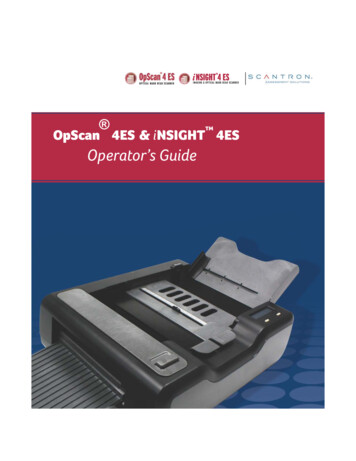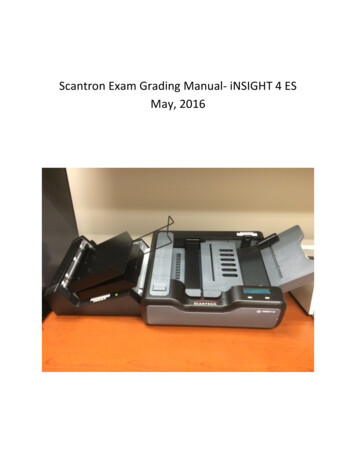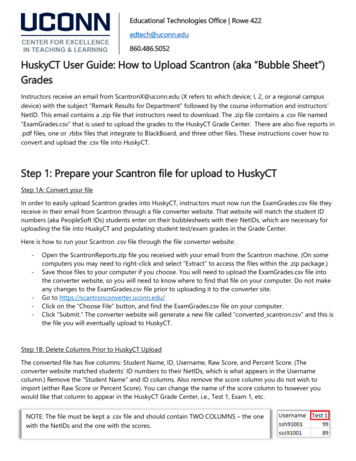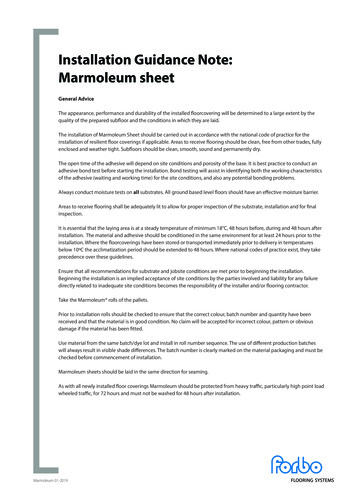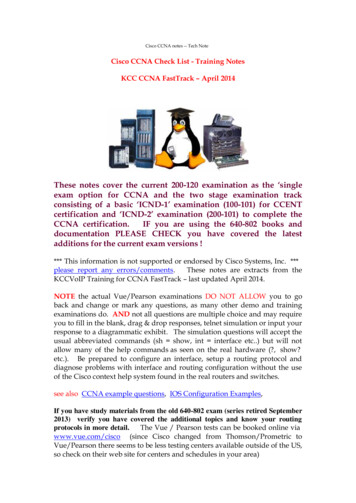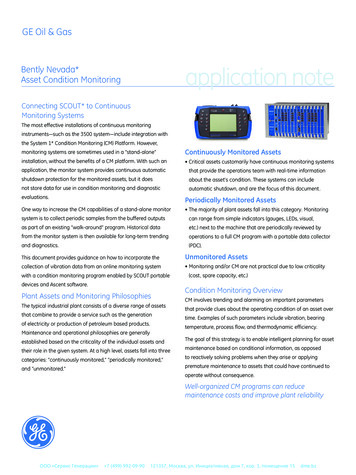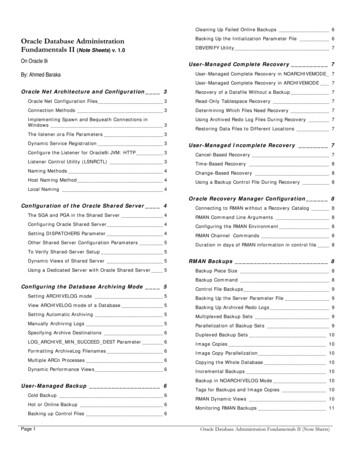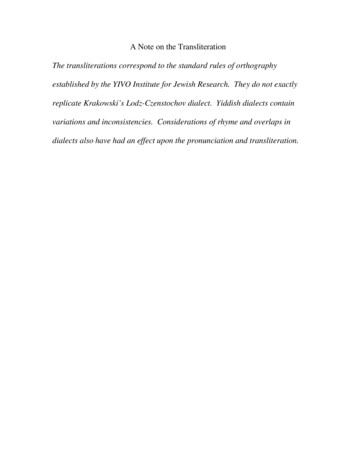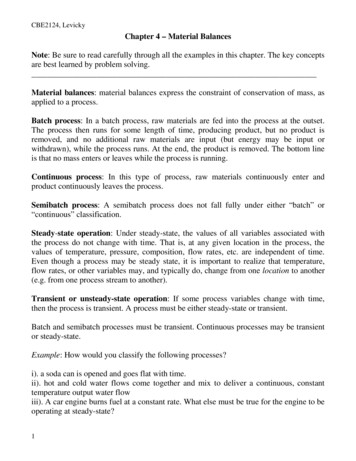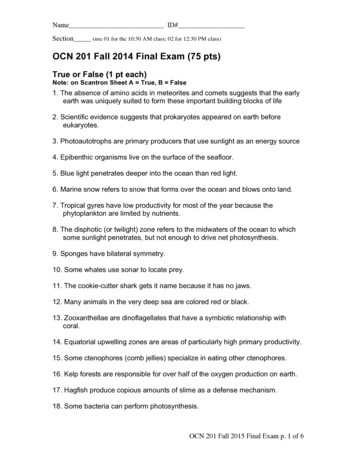
Transcription
Name ID#Section (use 01 for the 10:30 AM class; 02 for 12:30 PM class)OCN 201 Fall 2014 Final Exam (75 pts)True or False (1 pt each)Note: on Scantron Sheet A True, B False1. The absence of amino acids in meteorites and comets suggests that the earlyearth was uniquely suited to form these important building blocks of life2. Scientific evidence suggests that prokaryotes appeared on earth beforeeukaryotes.3. Photoautotrophs are primary producers that use sunlight as an energy source4. Epibenthic organisms live on the surface of the seafloor.5. Blue light penetrates deeper into the ocean than red light.6. Marine snow refers to snow that forms over the ocean and blows onto land.7. Tropical gyres have low productivity for most of the year because thephytoplankton are limited by nutrients.8. The disphotic (or twilight) zone refers to the midwaters of the ocean to whichsome sunlight penetrates, but not enough to drive net photosynthesis.9. Sponges have bilateral symmetry.10. Some whales use sonar to locate prey.11. The cookie-cutter shark gets it name because it has no jaws.12. Many animals in the very deep sea are colored red or black.13. Zooxanthellae are dinoflagellates that have a symbiotic relationship withcoral.14. Equatorial upwelling zones are areas of particularly high primary productivity.15. Some ctenophores (comb jellies) specialize in eating other ctenophores.16. Kelp forests are responsible for over half of the oxygen production on earth.17. Hagfish produce copious amounts of slime as a defense mechanism.18. Some bacteria can perform photosynthesis.OCN 201 Fall 2015 Final Exam p. 1 of 6
19. The largest spill of oil into the ocean resulted from a tanker accident.20. The whaling moratorium in place since the mid-eighties has effectivelystopped all whaling activities.21. The uppermost zone of the sea is known as the abyssopelagic.22. Bayesian mimicry is when a non-toxic species evolves to look similar to atoxic one.23. Surface waters in tropical oceans are very warm, which makes it easier fornutrients in cold deep water to mix to the surface.24. Animals are more abundant the deeper you go in ocean, because of all thefood falling down from the surface layer.25. The global yield of wild-caught fish has been increasing dramatically over thepast ten years.Multiple Choice (2 points each)26. A placozoan is:A. one of the most primitive types of animalsB. an extinct marine reptileC. an encrusting algaD. a geological epoch27. An animal that eats only other herbivorous animals is a:A. parasiteB. secondary consumerC. primary producerD. photoautotroph28. At hydrothermal vents, some bacteria get the energy to drive chemosynthesisfrom:A. oxidation of hydrogen sulfideB. oxididation of sugarsC. sunlightD. heat29. Countershading refers to:A. having a reduced silhouette to avoid being seen from the frontB. having a light colored belly and a dark colored backC. having light organs under the eyes to use as a flashlight to find preyD. producing chemiluminescent light on the back as a means of camouflageOCN 201 Fall 2015 Final Exam v. B p. 2 of 6
30. Coccolithophores are phytoplankton that helped form which of these massivegeological feature:A. Uluru (Ayers Rock)B. Bonneville Salt FlatsC. White Cliffs of DoverD. Snake River Canyon31. Which one is a feature of mysticete whalesA. one blowhole openingsB. teethC. use echolocationD. baleen32. The maximum number of a fish that can be caught each year withoutdepleting the stock in future years is known as the:A. recommended harvestB. maximum sustainable yieldC. maximum profit pointD. tragedy of the commons33. For the graph at right, what does the blackregion labeled “A” represent?:A. aquaculture productionB. capture fisheries productionC. net profitD. global fisheries by-catch34. Which is NOT true of larvaceans (animal illustrated at right):A. their discarded “houses” contribute to marine snowB. they are filter feedersC. they are chordatesD. they are a type of planktonic sponge35. The theory that describes the origin of eukaryotes as arising from the mergerfrom multiple prokaryotic cell types is known as The:A. Phlogiston TheoryB. Serial Endosymbiosis TheoryC. Unification TheoryD. Abiogensis Theory36 What kind of symbiosis exists between a cleaner shrimp and an eel (the eelgets a cleaning, the shrimp gets a meal):A. parasitismB. commensalismC. mutualismD. cannibalismOCN 201 Fall 2015 Final Exam v. B p. 3 of 6
37. The classification below that applies ONLY to animals is:A. planktonB. neriticC. intertidalD. nekton38. Oxygenic photosynthesis produces oxygen as a waste product. What is theprimary product?A. lipidsB. carbon dioxideC. sugarD. amino acids39. Oil entering the ocean is not considered pollution if it:A. is not visible on the surfaceB. is degradable by bacteriaC. is flowing from a natural seepD. all of the above40. Mercury is a bioaccummulating (or biomagnifying) toxin. In this drawing oftrophic levels, which statement would be true of trophic level five relative totrophic level three? Tophic level five has:A.B.C.D.higher biomass, lower mercury concentrationhigher biomass, higher mercury concentrationlower biomass, lower mercury concentrationlower biomass, higher mercury concentrationSHORT ANSWER QUESTIONS START ON THE NEXT PAGEOCN 201 Fall 2015 Final Exam v. B p. 4 of 6
Short Answer. (4 points each):41. The graph below shows how photosynthesis and respiration change withdepth. Fill in the blanks to indicate which line represents photosynthesis andwhich represents respiration (2 points). What is the name of the depth wherethey two lines cross (2 points)?Dashed line represents:Solid line represents:Where the lines cross is called the depth.42. In a food chain, the amount of biomass is less and less at each successivelyhigher trophic level (as illustrated below). What is the term for this distribution(2 points) and why does this happen (2 points)?43. Most bioluminescence is blue or blue-green, but one group of fish produces arare red bioluminescence. What are two ways (2 pts each) that having redbioluminescence helps them?(three more questions on next page!)OCN 201 Fall 2015 Final Exam v. B p. 5 of 6
44. This graph shows how the amount ofphytoplankton in the water changes overthe course of a year (starting in January)in three different areas of the ocean(tropical, north temperate, and northpolar). For the line marked “B”, which ofthose three areas does this represent (2points)? And why does it display thatpattern (2 points)?45. This figure from class illustrates the “deep scattering layer”, which wasdiscovered while testingsonar devices. Thissound-scattering layer isin the mesopelagic duringthe day and rises to thesurface as eveningapproaches. Why does itcome up at night (2 pts)?Why does it go downduring the day (2 pts)?OCN 201 Fall 2015 Final Exam v. B p. 6 of 6
Note: on Scantron Sheet A True, B False 1. The absence of amino acids in meteorites and comets suggests that the early earth was uniquely suited to form these important building blocks of life 2. Scientific evidence suggests that prokaryotes appeared on earth before eukaryotes. 3. Photoautotrophs are primary producers that use sunlight as an energy source 4. Epibenthic organisms live on .
